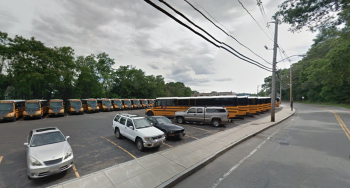Photo: Pare’s Amy Archer (l) listening to Selectmen Chair Adam Dash.
By a slim 2-1 margin, the Belmont Board of Selectmen voted to support placing a portion of a proposed community path from a new underpass at Alexander Avenue to Brighton Street along the south side of the commuter rail tracks, avoiding the residential neighborhood along Channing Road.
While it is the board’s preference, a south route is far from a slam dunk. Previous discussions with Purecoat North indicated the company was willing to sell the entire building – currently the home of the dog daycare facility Crate Escape – for upwards of $6 million for the entire structure, an amount Selectman Mark Paolillo called “unacceptable.”
The meeting was called to answer a simple question, said Chair Adam Dash: “If you know then what you know now, would you still support a south route for the path.” The quire was directed at Amy Archer, the consultant for the Pare Corporation which wrote the feasibility study of the entire community path which was presented in 2017.
Dash also said the selectmen have an increasingly tight time constraint on selecting a path as Town Meeting will have a $1 million Community Preservation Committee grant for design work to vote on and the town was preparing to seek state money for other work.
The board accepted Pare’s recommendation in which the path would run on the north side of the commuter rail line from Belmont Center to a proposed underpass at Alexander Avenue then proceeding along the south side to Brighton Street.
But the town and the board reopened the process in the fall of 2018 when word came from the MBTA and the MassDOT – who will determine which rail to trail projects around the state should receive funding – voiced considerable concern for the south route as it led commuters, pedestrians, and others to cross the rail tracks at an angle, which is a
At Monday’s meeting, Archer reiterated much of the initial findings which pointed out that as both the south and north options approached the Brighton intersection, they would encounter “pinch points” that will reduce the width the path to less than optimum ratios for safety and traveling.
Along the north side, there are 600 feet of path abutting property owned by FE French Construction, that would make it difficult for emergency vehicles to “literally open their doors” said Archer, if they were needed.
The southerly route would also meet a barrier of the Purecoat building of roughly 80 feet. But there was a solution, according to Archer; the acquisition by the town of a portion of the building, which would be removed or designed in a way to allow the necessary width for travel and first responders.
Archer said the study determined that “some negotiation” with the building owner on what they determined would be a “minor impact” to the structure. There was one catch to the building; it has been determined that soil is contaminated, which brings into play the state’s Superfund law, known as Chapter 21E, which describes the legal obligations of property owners and other potentially responsible parties when contamination is found which has its own potentially high price tag.
While running the path along Hittinger Street to Brighton to bypass the congestion point has been suggested and was in the feasibility study, the selectmen essentially rejected that proposal as well as taking the building through eminent domain laws.
Archer also noted that safety at Brighton Street intersection could be resolved with additional gates along the sidewalks. She noted that due to the future increased levels of the pedestrian, bike, and vehicular traffic on Brighton Avenue will require the intersection to be redesigned for increased safety and effective traveling whether the path is built or not.
After the presentation, Dash asked if Archer’s decision from 2017 to recommend the southern route was still valid.
“The Pare team stands by that decision,” Archer told the board.
The board debated the “new” information, pondering whether to delay a decision or simply bite the bullet and make a final determination. In the end, the majority – Tom Caputo and Paolillo – settled on the compromise to select a southern route but only if and when “successful” negotiations with Purecoat.
“I can’t go against our expert consultants that were supported by the Community Path Advisory Committee,” said Paolillo.


